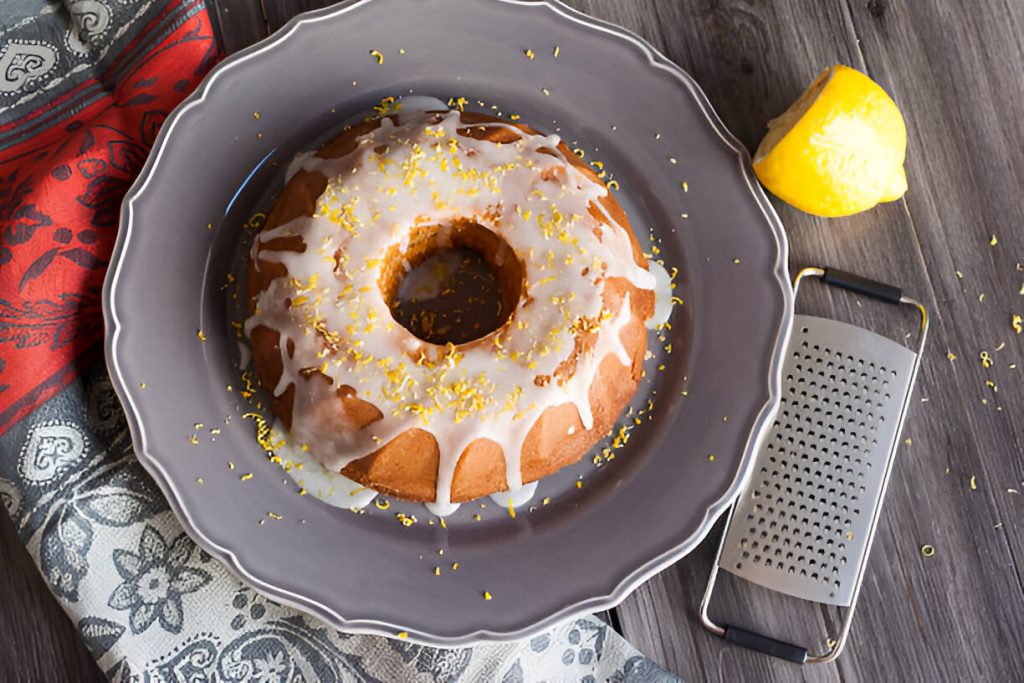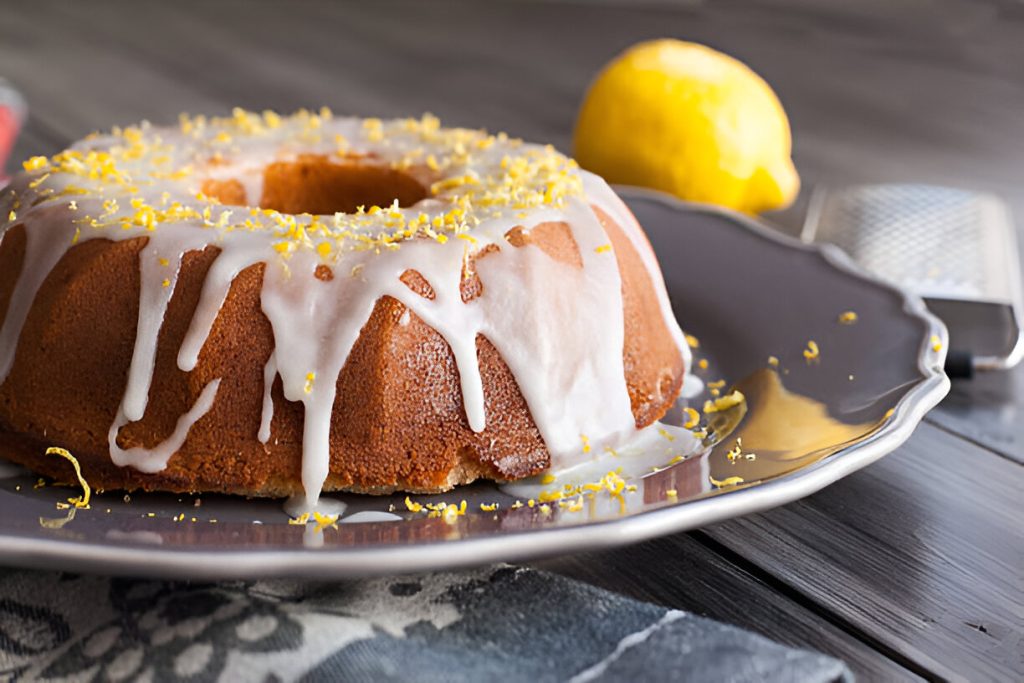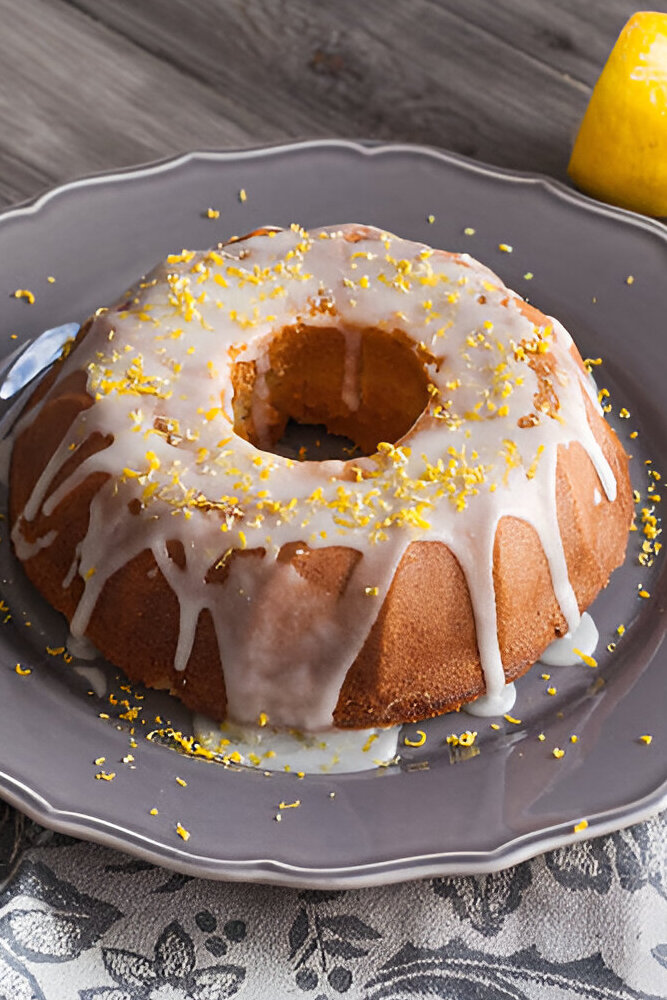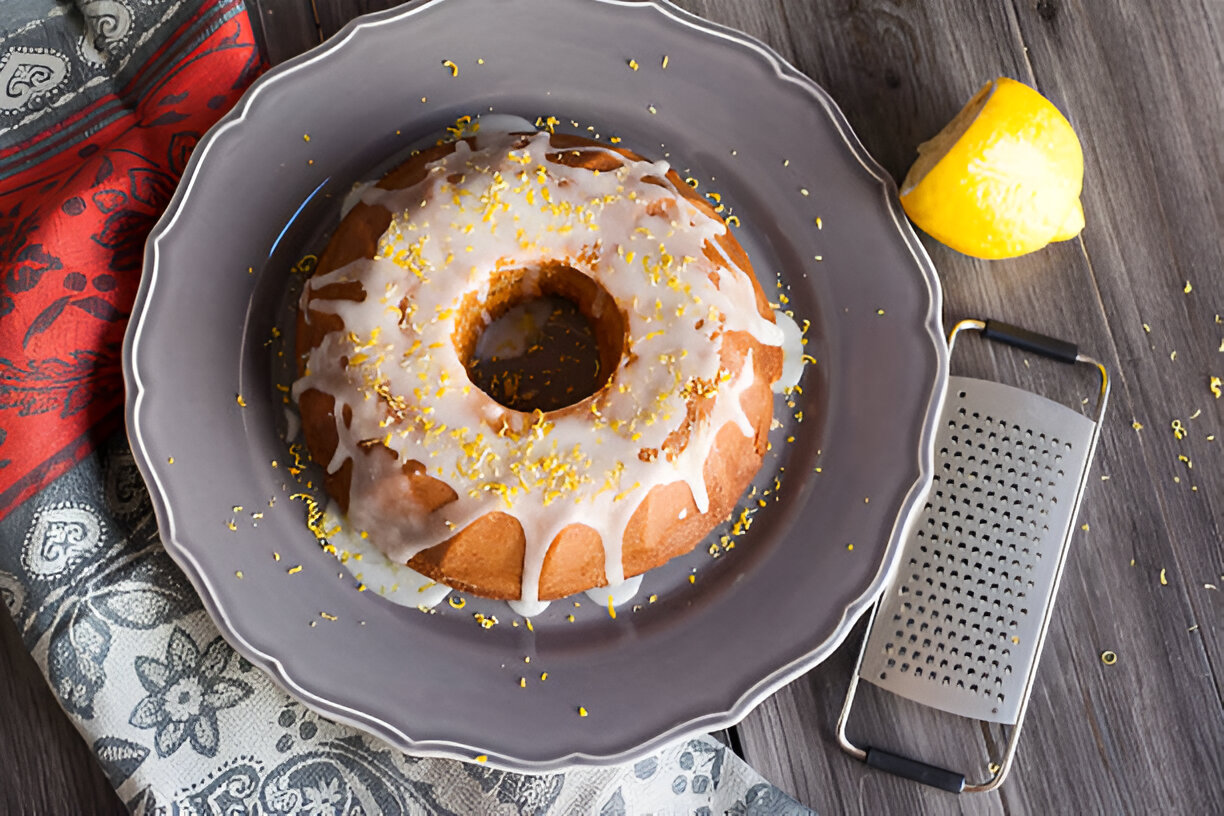Lemon Bundt Cake Recipe
Lemon Bundt Cake is a classic dessert that delivers a delightful balance of zesty lemon brightness and rich buttery goodness. This cake is soft, tender, and bursting with citrus flavor, making it a perfect treat for any occasion. With its simple yet elegant preparation, it’s the type of recipe that feels both indulgent and refreshing, ideal for family gatherings or casual tea-time moments. The combination of fresh lemon zest, juice, and a buttery glaze makes every bite a heavenly experience.

Ingredients Overview
The key to achieving the perfect Lemon Bundt Cake lies in the quality and combination of ingredients. Fresh lemons are essential to infusing the cake with a vibrant citrus flavor. The zest, full of aromatic oils, complements the tangy lemon juice, adding both depth and freshness. Unsalted butter, used generously, provides richness and a tender crumb, while sour cream adds moisture, keeping the cake soft without being too dense. A mix of all-purpose and cake flours ensures the right balance of structure and lightness, while the sugar creates the ideal sweetness that enhances the lemon’s natural tartness. Every element works harmoniously to create a beautifully balanced and flavorful cake.
Step-by-Step Instructions
To begin, preheat your oven to 350°F and prepare your bundt pan, as a well-greased pan is crucial to avoid sticking. Sift the dry ingredients—both types of flour, baking powder, and salt—together to ensure even distribution, setting the stage for a smooth batter.
In another step, a high-speed blender or food processor will become your best friend. Pulse the sugar with the lemon zest to evenly disperse the oils and maximize the flavor infusion. Once you add the eggs, lemon juice, and sour cream to this mixture, pulse until everything is combined smoothly. Slowly pouring in the melted butter ensures the batter stays rich without separating, and mixing everything on low keeps the ingredients emulsified.
When combining the wet and dry ingredients, avoid overmixing, as it could result in a tougher texture. The batter will be somewhat thin, so don’t be alarmed. After pouring it into the bundt pan, ensure the batter is spread evenly. Bake for 50 to 60 minutes, testing for doneness by inserting a toothpick—if it comes out clean or with a few moist crumbs, the cake is ready. Allow the cake to cool in the pan for about 15 to 20 minutes, then gently loosen the edges before turning it onto a cooling rack. Patience is key here to avoid breaking the cake.

Recipe Tips & Frequently Asked Questions
How to properly zest lemons for maximum flavor:
When zesting, be careful not to include the bitter white pith. Use a microplane or fine grater for the best results, ensuring the zest is finely grated to distribute evenly throughout the batter.
How to know when the cake is done baking (toothpick test):
Insert a toothpick into the center of the cake. If it comes out clean or with a few moist crumbs clinging to it, the cake is done. Avoid overbaking, as it can dry out the cake.
Cooling tips to ensure easy release from the bundt pan:
Allow the cake to cool for about 15 to 20 minutes before attempting to remove it. Gently run a thin knife around the edges to loosen any stuck parts, then invert the pan onto a cooling rack. If greased properly, the cake should release smoothly.
Can this cake be made ahead of time?:
Yes, you can bake the cake a day in advance. Store it in an airtight container to retain its moisture and glaze it just before serving.
How should the cake be stored, and how long does it last?:
Store the cake at room temperature in an airtight container for up to three days. Alternatively, you can refrigerate it for up to a week, though it’s best served at room temperature for optimal flavor and texture.
Can this recipe be adapted for cupcakes or sheet cake?:
Absolutely! The batter can be used for cupcakes or a sheet cake, though baking times will vary. Cupcakes will take around 20-25 minutes, and a sheet cake will bake in about 35-40 minutes.
What to Serve With This Recipe
A slice of Lemon Bundt Cake can stand alone as a perfect dessert, but why not enhance the experience with a few complementary pairings? For a creamy touch, serve it alongside a dollop of freshly whipped cream or a scoop of vanilla ice cream. The richness balances the tartness of the lemon beautifully. Alternatively, fresh berries like raspberries or blueberries add a burst of natural sweetness and color contrast. For an extra indulgent twist, drizzle the cake with a bit of lemon curd, which mirrors the bright lemon flavors in the cake while adding a velvety texture.
Glaze Variations
While the classic lemon glaze is tangy and sweet, you can get creative with different variations to suit your palate or the occasion. For a citrusy twist, swap the lemon juice in the glaze for orange or lime juice, creating a unique spin on the original recipe. For a richer, deeper flavor, add a hint of vanilla or almond extract to the glaze, bringing complexity to the cake’s sweetness. If you prefer a thinner glaze, increase the milk or cream slightly, allowing the glaze to soak into the cake for a more subtle finish. These small changes can elevate the cake and make it versatile enough for different tastes and celebrations.
When serving Lemon Bundt Cake, presentation is key to making it feel as special as it tastes. For a striking visual, garnish the top with thin slices of fresh lemon, or place a few edible flowers around the base for a pop of color. A light dusting of powdered sugar adds a delicate touch, making the cake look effortlessly elegant. If you’re serving this cake at a special event, consider slicing it and arranging the pieces on a cake stand, allowing guests to appreciate the golden hue and glaze. Whether simple or adorned, this cake will always shine.

Ingredients
For the cake:
4 sticks (452 grams) unsalted butter, melted and cooled
4 tablespoons fresh lemon zest (from about 6 lemons)
2 teaspoons baking powder
2 1/2 cups (500 grams) granulated sugar
2 1/2 cups (313 grams) powdered sugar
2 tablespoons fresh lemon juice
2 tablespoons milk or cream
1 teaspoon fine salt
1 1/2 cups (191 grams) all-purpose flour
1 1/2 cups (170 grams) cake flour
1/2 cup (120 grams) sour cream*, at room temperature
8 large eggs, at room temperature
For the glaze:
2 tablespoons fresh lemon juice
2 tablespoons milk or cream
2 1/2 cups (313 grams) powdered sugar
Instructions
Make the cake:
Preheat your oven to 350°F and set it aside while you prepare the cake batter.
In a large bowl, sift together the all-purpose flour, cake flour, baking powder, and salt. Keep this dry mixture aside.
Using a food processor or high-speed blender, blend the granulated sugar with the lemon zest. Pulse a few times to evenly distribute the zest’s fragrance and flavor. Add in the lemon juice, eggs, and sour cream, pulsing until all ingredients are well combined. Gradually, with the processor on low, slowly pour in the melted butter, blending until fully incorporated.
Create a well in the center of the flour mixture and pour the wet ingredients into the dry. Use a rubber spatula to gently fold the mixture together until just combined. The batter will have a slightly runny consistency.
Generously grease a 10 or 12-cup bundt pan with baker’s nonstick cooking spray or melted shortening, ensuring all the nooks and crannies are well.
Pour the batter into the prepared pan immediately.
Bake for 50 to 60 minutes or until a toothpick inserted in the center of the cake comes out clean or with a few moist crumbs attached. Once done, allow the cake to cool in the pan for 15 to 20 minutes before running a thin knife around the edges and inverting it onto a cooling rack. Let the cake cool completely.
Make the glaze:
In a small bowl, whisk together the powdered sugar, lemon juice, and milk or cream until smooth. Drizzle the glaze over the cooled cake. Allow it to set before serving.

Lemon Bundt Cake Recipe
Ingredients
For the cake:
- 4 sticks 452 grams unsalted butter, melted and cooled
- 4 tablespoons fresh lemon zest from about 6 lemons
- 2 teaspoons baking powder
- 2 1/2 cups 500 grams granulated sugar
- 2 1/2 cups 313 grams powdered sugar
- 2 tablespoons fresh lemon juice
- 2 tablespoons milk or cream
- 1 teaspoon fine salt
- 1 1/2 cups 191 grams all-purpose flour
- 1 1/2 cups 170 grams cake flour
- 1/2 cup 120 grams sour cream*, at room temperature
- 8 large eggs at room temperature
For the glaze:
- 2 tablespoons fresh lemon juice
- 2 tablespoons milk or cream
- 2 1/2 cups 313 grams powdered sugar
Instructions
Make the cake:
- Preheat your oven to 350°F and set it aside while you prepare the cake batter.
- In a large bowl, sift together the all-purpose flour, cake flour, baking powder, and salt. Keep this dry mixture aside.
- Using a food processor or high-speed blender, blend the granulated sugar with the lemon zest. Pulse a few times to evenly distribute the zest’s fragrance and flavor. Add in the lemon juice, eggs, and sour cream, pulsing until all ingredients are well combined. Gradually, with the processor on low, slowly pour in the melted butter, blending until fully incorporated.
- Create a well in the center of the flour mixture and pour the wet ingredients into the dry. Use a rubber spatula to gently fold the mixture together until just combined. The batter will have a slightly runny consistency.
- Generously grease a 10 or 12-cup bundt pan with baker’s nonstick cooking spray or melted shortening, ensuring all the nooks and crannies are well
- Pour the batter into the prepared pan immediately.
- Bake for 50 to 60 minutes or until a toothpick inserted in the center of the cake comes out clean or with a few moist crumbs attached. Once done, allow the cake to cool in the pan for 15 to 20 minutes before running a thin knife around the edges and inverting it onto a cooling rack. Let the cake cool completely.
Make the glaze:
- In a small bowl, whisk together the powdered sugar, lemon juice, and milk or cream until smooth. Drizzle the glaze over the cooled cake. Allow it to set before serving.

